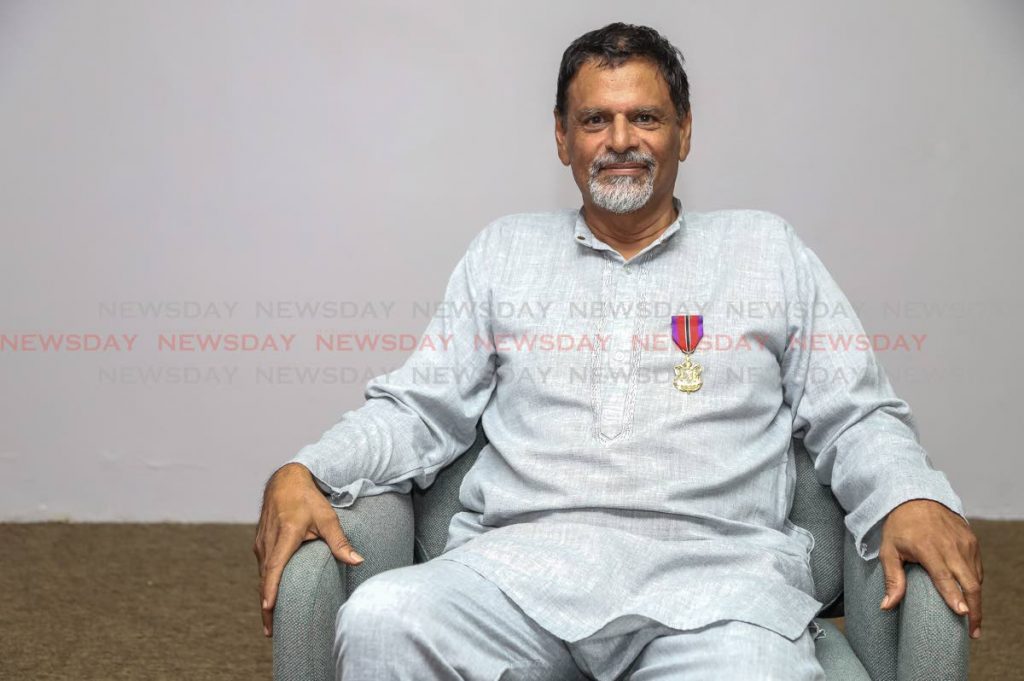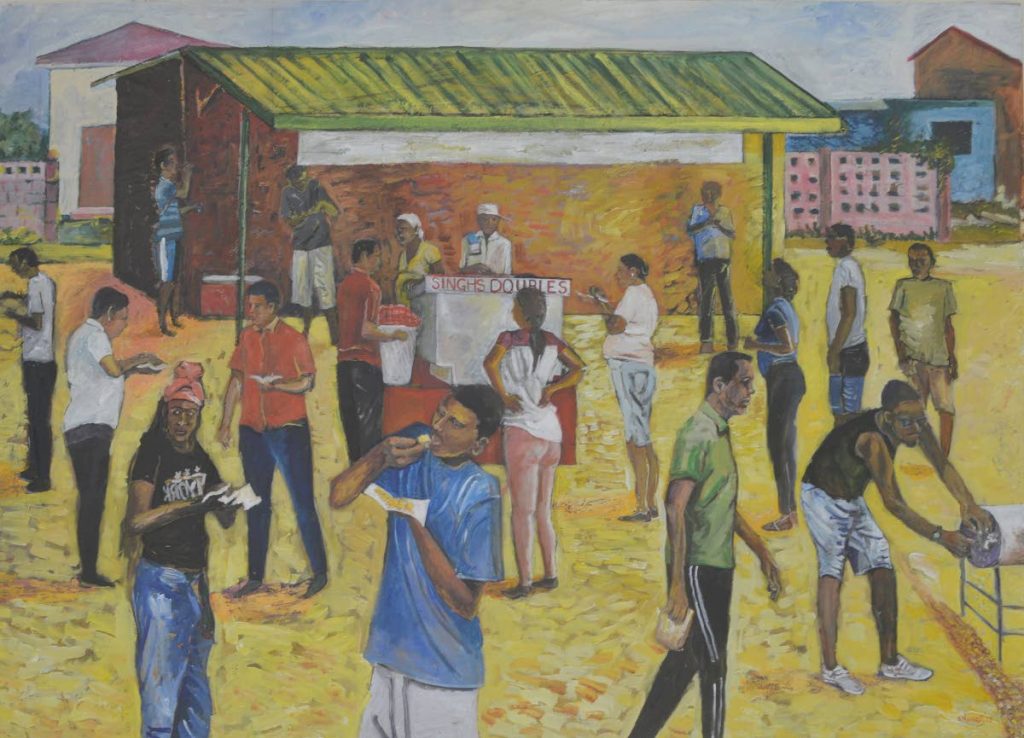Shastri Maharaj: 'Art is my service'

For decades he has been working to educate and sensitise people on the importance of art, as well as to expand his own artistic understanding.
Yet, when Shastri Maharaj, 66, was nominated to receive the Public Service Medal of Merit (Gold) on September 24, he did not expect it.
“I was stopped in my tracks because I didn’t give it much thought prior to them calling me. I felt like the fruits of my labour finally paid off.”
He described the award, not only as an affirmation but as a catalyst to continue experimenting and exploring so that he could continue sharing with and contributing to the country. In fact, he said he was excited and fuelled by it.
Maharaj is an artist, an art lecturer at Valsayn Teachers’ College, a former lecturer at the University of TT, a former secondary school teacher, and the former curriculum co-ordinator in Visual and Performing Arts at the Ministry of Education. He also wrote the school textbook Visual Arts for Secondary Schools.
Over his 40-year career he has had 20 one-man shows, including exhibitions in Toronto, India, Germany, the US, and other Caribbean countries, as well as several international mixed exhibitions. He has been invited to workshops in Mauritius in east Africa, and Chile, where he worked with children, and is responsible for the design of the walkway on Harris Promenade, San Fernando.

Since receiving the award, Maharaj said he has been on a high because of the congratulations from friends and strangers, in person and on social media. He described it as “living where the air is rare.” He said it is an incredible experience that cannot compare to previous publicity for his exhibitions or being recognised as an artist from newspaper, radio or television interviews.
He stressed that it was not something he could have achieved without his wife of 40 years, Shirley Christian Maharaj, who he said is his anchor who pulls him back when he strays too far.
Asked if he felt he deserved the award, he said, “I am not preoccupied with deserving. I’m preoccupied with service, with giving, with doing. That’s my passion... I think the fact that I keep plodding along, persevering, and doing the work, and probably pursuing appropriate channels, rewards come. I don’t sit and say I’m waiting on some kind of accolade. My preoccupation is to do every day, because I have passion for what I do.”
WHAT IS TO BE
Maharaj told Sunday Newsday he was born to be an artist. He thanked Alexander King, his mentor and lecturer when he attended Valsayn Teachers’ College – the man he said is responsible for the direction of his art. He was also inspired by the late Carlisle Chang and Isaiah James Boodhoo.

He said he developed a signature style of women in bleak and empty landscapes, though there have been subtle changes in his work over the years.
“I’m dealing with the essence of the landscape, the emptiness of it, the silence of it. And in that emptiness and silence is where we, the looker, would like to venture into...I just let whatever wants to come out, come out.”
He said most of his paintings deal with TT society because it is what he knows and so his “Indianness” comes out most of the time. He described his work as social and visual commentary on TT’s landscape, its people, and its culture.
Maharaj said he grew up as an “urban Indian” in San Fernando but during that time he had no idea where his life would lead. He did not grow up in an environment that supported creativity as a career, because it was not mainstream. He was, he recalled, misunderstood, rebellious, revolutionary, and did not want anything to do with Hinduism or any religion.
“Mind you, now in my life there are certain attributes of Hinduism that naturally preoccupy my space, like Indian food, some types of Indian music, Indian women, I do a lot of yoga – I extract things that I like. I like to keep exploring what I take for granted...

“I want to peel off the layers of ignorance that have been conditioned in me through religion, through education, through society, through my parents, because I am really the cosmos. I’m from the universe – no beginning and no end. And in my art and in my pursuit for whatever, it’s to go to that realm of insight.”
He said yoga helped him connect to silence. Many people in TT preferred noise but in silence there is knowledge, meditation and growth, he said, and silence was where people can “go within” and have the universe at their disposal. This is where he gets his energy for life, his paintings, and to deal with love and humility.
“We come from love, we live in love and we should stay in love. It is this lack of love, this malice, that is creating a cancer in this country, because people do not have constructive outlets for their pent-up energies.”
Painting is not Maharaj’s only passion. He plays the cuatro in a parang band, Los Ketchos Assos, and parangs homes in San Fernando every Sunday before Christmas Day. He also loves to cook, enjoys the outdoors, and used to be a member of the San Fernando Drama Guild.
“I was an actor before the Naparima Bowl burnt down. I acted in (VS) Naipaul’s Mystic Masseur and appeared as a doctor in (the local soap opera) Westwood Park. Acting has been another strong point of mine. But at some point I had to make the decision: acting or art. My wife insisted that I do art and not drama, because I had to go San Fernando and we live in Chaguanas.”
ARTIST AND TT SOCIETY
Maharaj had several suggestions on how to promote art, which he said massages the senses and emotions, in TT.
He said the government has to set the example by providing facilities for artists to display their work, and he does not include the national museum, because he considers it defunct.
“We need a proper art gallery so artists could have their work displayed in the kind of sobering environment that it requires. Therefore, the society can look at a national art gallery and say, ‘The government respects visual art.’”
A national art gallery would go a long way in sensitising the public, especially schoolchildren, and letting them know that art is legitimate and a necessary part of the country’s culture.
“If there are not a lot of forums for artists to discuss and display art, how can we sensitise the public in wanting to appreciate, embrace, or even purchase art. If there are no other avenues available for it other than the commercial galleries?”
He added that government should have a policy of dedicating two to five per cent of the budget to buying local art for its offices when using or constructing new buildings. This includes more local art on display at Piarco International Airport so people can appreciate the work of local artists as they enter the country.
He also suggested art outreach programmes in rural areas where artists could host workshops with youths, could be given a stipend and basic art materials provided by the government, and the media could highlight it to sensitise people to the value of art in the lives of everyone.
He said he never sees children at his exhibitions, as they are not brought by their parents or on school field trips. But he feels art should be encouraged as an avenue for youths to feel good about themselves.
He added that Carifesta this year was an example of the little respect and support shown to visual arts, as there was no proper budget to effectively host and display art.
“I don’t think there’s a visual arts officer in the Ministry of Culture. They are still heavily caught up in the performing arts.
"So if you don’t even have a visual arts officer, where is visual arts going?”
PHOTOS:
MAHARAJ RECEIVING AWARD FROM PRESIDENT - ROGER
MAHARAJ WITH AWARD IN OFFICE - JEFF
PAINTINGS FROM PREVIOUS STORY "Art for the grassroots"

Comments
"Shastri Maharaj: ‘Art is my service’"